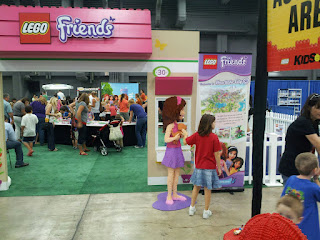LEGO and the Future of Gaming
We went to a Lego show on Friday at the Austin Convention Center.It was a three-day event, and the first "session" was at 4 p.m. on Friday. We picked up Eli 11.1 from school and drove straight there, walking in about 4:10. By 4:45, it was packed.
Five years ago, I thought LEGO was dead.
I made sure that Eli had a few sets, just for nostalgia's sake, and we went to LEGOLAND (okay, I'm stopping this all-caps shit right now)--where I had a fantastic time, even more so than Eli--but Lego seemed out of touch with kids.
I regretted this deeply, as I strongly believe that the process of creating Lego models builds all kinds of strongly integrated intelligence.
Lego's financials, though, were spiraling downwards--not unlike the game industry today, really--and the company appeared to be in "a rapidly decaying orbit of failure" (not my phrase, but I like it).
I always felt that, in today's world, Lego was a tough sell. It was such an exploratory, non-guided experience--which is wonderful--but it didn't seem to mesh well with how kids experience life in the U.S. these days, which is a much more guided experience.
That strongly-guided experience has made kids much more savvy, in many ways, at a much earlier age, but it hasn't helped their creativity. Kids are far less creative than they were in 'the old days', just because they have so little time to create compared to the old days. So Lego didn't align well with American kids anymore.
Inside the convention center, though, there was an almost explosive amount of energy. Something, clearly, had happened while I wasn't paying attention.
So I started paying attention.
I realize that Lego's direction would be clearly on display inside the convention center. And I also realized that if I could understand how Lego reinvented itself, it might help me understand what gaming companies could do to survive in an increasingly hostile environment.
The entire convention floor broke down into a very simple maxim: "see, build, buy."
First off, you'd walk in and be wowed by the life-size Lego models of Indiana Jones and Johnny Depp and Darth Maul and all kinds of other giant figures:
See.
Next, beyond that initial area, were plenty of areas where you could build. There was an area where the host called out a type of figure for everyone to build, and they had five minutes to do it (our task: robots). The parents were all building, too.
There was also an area to build vehicles and race them on a downhill track, plus some building areas for younger kids. The showpiece, though, was a huge floor area in the shape of the United States. Anyone could build on a "ground tile" about 7"x7", and when you were done, you handed your tile to someone who would place it inside the United States outline (you could even ask for a specific location). It was a tremendously clever idea, both individual and collective.
There was also the brick pile:
Build.
In the back of the convention center was a retail area where a huge number of Lego sets were available for purchase, and boy, there was a lot of purchasing going on.
Buy.
Lego has also done something very clever in terms of their marketing, which I had no idea was happening until I saw this:
That's right--Legos specifically targeted at girls, or--more accurately--the girl demographic that didn't already play with traditional Legos.
Like I said, this convention was bursting with energy. Well, except for this guy:
By the way, Lego's revenue was up 24% for the first six months of this year, and profits were up 35%. So in a challenging environment, they have adapted.
Tomorrow: what the gaming industry can learn from Lego.





<< Home